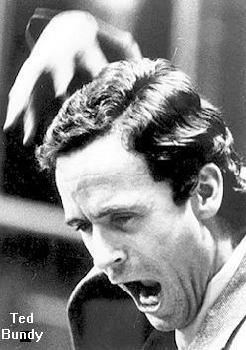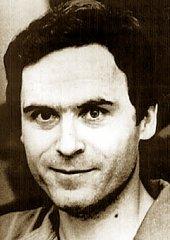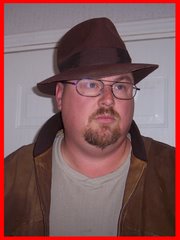 Theodore Robert Bundy an American serial killer who killed many young women in Washington, Utah, Colorado and Florida between 1974 and 1978. His total number of victims is unknown. Bundy has confessed to some 30 murders but police estimates run above 100.
Theodore Robert Bundy an American serial killer who killed many young women in Washington, Utah, Colorado and Florida between 1974 and 1978. His total number of victims is unknown. Bundy has confessed to some 30 murders but police estimates run above 100. Bundy is thought to have been a sociopath. He was highly intelligent, educated, personable, handsome, and charming, but nevertheless, regularly brutally murdered women and girls, usually with a blunt instrument, sometimes by strangulation. He would also often sexually assault his victims before and after they had died.
Bundy was born in November 1946, to Eleanor Louise Cowell, a young department store clerk. His father's identity has never been established. For the first five years of his life, Ted and his mother lived with his psychologically unstable grandfather in Philadelphia. At age four, he appeared at his aunt's bed one morning, smiling as he brandished several knives.
Louise and Ted soon thereafter moved to Tacoma, Washington, where her uncle Jack taught music at the College of Puget Sound. Not long thereafter, Louise married John Culpepper Bundy, Ted took the last name.
Friends generally recalled Bundy as a happy, normal child. He was a good student at Woodrow Wilson High School, and was active in the Methodist Church as well as the Boy Scouts. However, as he told Stephen Michaud and Hugh Aynesworth, authors of Bundy's definitive biography The Only Living Witness, Ted had no natural sense of how to get along with other people. "I didn't know what made people want to be friends," he told the authors. "I didn't know what made people attractive to one another. I didn't know what underlay social interactions."
This other self, Ted's "entity," as he described it to Michaud and Ayneswroth, was kept very well hidden. Later, friends and acquaintances would all remember a handsome, articulate young man. The extroverted Bundy worked and campaigned for the Republican Party as an adult. He also worked as a volunteer at a Seattle rape crisis center, alongside fledgling crime reporter Ann Rule who, ironically, wrote articles on the "Ted" murders that, unbeknownst to her, her young friend was committing. Years later, Rule would write the definitive biography on Bundy, The Stranger Beside Me.
Bundy had one serious relationship before his serial killing began in earnest, with a college freshman whom Ann Rule referred to by the pseudonym "Stephanie Brooks." At one point she ended the relationship due to a lack of ambitiousness on Bundy's part, and they separated for a period of roughly two years. Ted eventually came back into her life, courted her once more, and then proposed. She agreed to marry him. Two days later, he unceremoniously dumped her by ceasing to return her phone calls. It was shortly after this final breakup that Ted began a homicidal rampage lasting three years.
Ann Rule theorized that "Stephanie" formed the archetype for Bundy's preferred victim: young, white female, with long dark hair parted in the middle.
While some experts, including former King County detective Robert D. Keppel, believe Ted may have started killing in his early to mid-teens (a twelve-year-old neighbor vanished from her house when Bundy was fourteen) the earliest verified murders began in 1974, when he was 27.
Shortly after midnight on 4 January 1974, Bundy entered the house of Joni Lenz, an 18-year-old student at the University of Washington, and bludgeoned her with a crowbar while she slept. Bundy also removed a bed rod from Lenz's bed and used it to sexually assault her. She was found the next morning, in a coma, lying in a pool of blood. Lenz survived the attack, but suffered permanent brain damage.
 Bundy's next victim was Lynda Ann Healy, a senior at the University of Washington. On 31 January 1974, Bundy broke into her room, knocked her unconscious, wrapped her in bedsheet, and carried her outside. A year would pass before her decapitated, dismembered remains were found.
Bundy's next victim was Lynda Ann Healy, a senior at the University of Washington. On 31 January 1974, Bundy broke into her room, knocked her unconscious, wrapped her in bedsheet, and carried her outside. A year would pass before her decapitated, dismembered remains were found.
From that January to June he stalked and killed more than one young woman a month, a spree that culminated in July with the double daytime abduction and murder of two females at a lakeside park near Seattle. He murdered approximately ten victims in Oregon, Utah and Washington. Bundy had a remarkable advantage as his facial features were charming yet not especially memorable. He would be later described as a chameleon, able to look totally different just by changing his hairstyle, for example.
That autumn, Bundy moved on to Utah, where the killings began in October with the murder in Midvale of Melissa Smith, the 17-year-old daughter of police chief Louis Smith. Bundy raped, sodomized, and strangled the Smith girl. Her body was found nine days later.
Next was Laura Aime, also 17, who disappeared on Halloween. Her remains were found nearly a month later, on Thanksgiving Day, on the banks of a river.
In Murray, Utah, on November 8, 1974, Carol DaRonch narrowly escaped with her life. Posing as a police officer, Bundy lured DaRonch into his car where he then attempted to slap a pair of handcuffs on her. Fortunately for DaRonch, he only got one wrist. She wrenched her door open with the other hand, rolled out of the car onto the highway, and escaped. Bundy was later captured and convicted of DaRonch's kidnapping on June 30, 1976. He was sentenced to one to 15 years in Utah State Prison. Colorado authorities, however, were pursuing their murder cases.
On June 7, 1977, in preparation for a hearing in his murder trial, Ted was transported to the Pitkin County, Colorado, courthouse. During a court recess, he was allowed to visit the courthouse's law library. Bundy then jumped out of the building from a second-story window and escaped. He wandered around the area before being recaptured a week later. Back in jail awaiting the start of his trial, Bundy escaped again. He somehow acquired a hacksaw and, over time, sawed a square hole in the ceiling of his cell in the Glenwood Springs, Colorado, lockup. On the night of December 30, 1977, Bundy climbed out of the hole, managed to reach the main hallway, and (because the jailer was out for the evening) was able to walk right out the jail's front door. Bundy stole a car in the parking lot and drove off into the night.
He flew TWA from Denver to Chicago, caught an Amtrak train to Ann Arbor, Michigan, then stole a car which he ditched in Atlanta before boarding a bus for Tallahassee. There, in the early hours of Super Bowl Sunday 1978, he bludgeoned two sleeping college women to death and seriously wounded two others inside their Chi Omega sorority house.
On February 9, 1978, Bundy traveled to Lake City, Florida. While there, he abducted and murdered 12-year-old Kimberly Leach. She would be his final victim. Shortly after 1 AM on February 15, Bundy was stopped by a police officer in Pensacola, Florida. When the officer called in a check of Bundy's license plate, the orange VW he was driving came up as stolen. Before long, Bundy was identified and taken to Miami to stand trial for the Chi Omega murders.
After being convicted, Bundy was sentenced to death by judge Edward Cowart. While under sentence of death, he was tried in Orlando for the Leach murder and was handed another death sentence by Judge Wallace Jopling. During this second trial, he married Carole Ann Boone, a former coworker and admirer. During his incarceration, Bundy received hundreds of fan letters from female admirers.
Judge Edward Cowart said, when sentencing Bundy to death:
"It is ordered that you be put to death by a current of electricity, that that current be passed through your body until you are dead. Take care of yourself, young man. I say that to you sincerely; take care of yourself. It's a tragedy for this court to see such a total waste of humanity as I've experienced in this courtroom. You're a bright young man. You'd have made a good lawyer, and I'd have loved to have you practice in front of me, but you went the wrong way, partner. Take care of yourself. I don't have any animosity to you. I want you to know that. Take care of yourself."'
This quote indicates that Bundy's persuasiveness and manipulative behavior was so well developed that it even affected the judge, still he was clearly was aware of Bundy's guilt.
In October 1982, his wife gave birth to their only child, a girl, whom Bundy adored. Eventually, however, Boone moved away, divorced him, and changed her and her daughter's last name. Apparently, she somehow discovered that Bundy was guilty—meaning that she had previously believed that Bundy was innocent, yet another testimonial to his unique ability to charm women.
In the years Bundy was on death row, he was often visited by Special Agent William Hagmaier of the FBI's Behavioral Sciences Unit. Bundy would come to confide in Hagmaier, going so far as to call him his best friend. Eventually, Bundy confessed to Hagmaier many details of the murders that had until then been unknown or unconfirmed.
In 1984, Bundy contacted King County homicide detective Robert Keppel and offered to assist in the ongoing search for the Green River Killer by providing his own insights and analysis. Keppel and Green River Task Force detective Dave Reichert traveled to Florida's death row to interview Bundy. Both detectives later stated that these interviews were of little actual help in the Green River investigation; they provided far greater insight into Bundy's own mind, and were primarily pursued in the hope of learning the details of unsolved murders that Bundy was suspected of committing but had never been charged with, let alone tried or convicted.
Bundy contacted Keppel again in 1988. With his appeals exhausted and execution imminent, Bundy seemed to wish to unburden himself by confessing to his crimes, which included eight officially unsolved murders in Washington State for which Bundy was the prime suspect. Bundy also hoped to manipulate the confessions into another stay of execution, as Keppel reported that he frequently gave scant detail and promised to reveal more and other body dump sites if he were given "more time", but the ploy failed and Bundy was executed on schedule.
The night before Bundy was executed, he gave a television interview to Dr. James Dobson, head of the Christian organization Focus on the Family. Bundy claimed that consumption of violent pornography helped "shape and mold" his violence into "behavior too terrible to describe." Ted Bundy said that he felt that violence in the media, "particularly sexualized violence," sent boys "down the road to being Ted Bundys." It is noteworthy that Bundy had never blamed pornography until this interview and no pornographic materials were found at his home when it was searched.
According to Special Agent Hagmaier, Bundy also contemplated suicide in the days leading up to his execution, but eventually decided against it.
At 7:06 AM on January 24, 1989, Theodore Robert Bundy was put to death by the State of Florida, by electrocution. The death warrant was for the Lake City murder. His last words were, "I'd like you to give my love to my family and friends." Then, an electric potential of over 2,000 volts was applied across his body for less than two minutes. He was pronounced dead at 7:16 AM. He was 42 years old.
 Theodore Robert Bundy an American serial killer who killed many young women in
Theodore Robert Bundy an American serial killer who killed many young women in  Bundy's next victim was Lynda Ann Healy, a senior at the
Bundy's next victim was Lynda Ann Healy, a senior at the 
1 comment:
Hey this is a nice blog. I think I'll bookmark it.
If you have the time, why not come and see my site about Track Lighting. You'll find it at Track Lighting.
keep the blogs comming.
Post a Comment